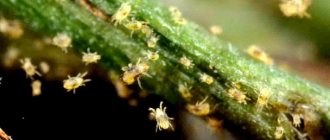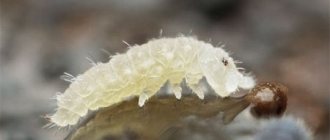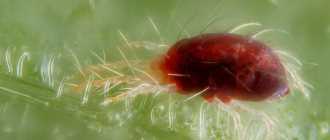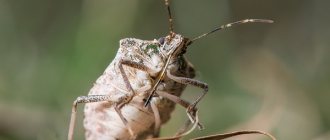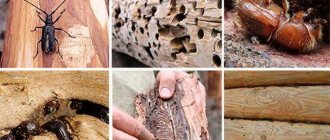Gardeners growing vegetables in greenhouses very often have to deal with various insects. The insect kingdom has about one and a half million species, a considerable part of which are pests. One of them is the common spider mite (Tetranychus urticae). Fighting ticks is not an easy task. This microscopic arthropod (0.2-1mm) survives under various conditions. One can only envy his vitality. It lives on all continents, without exception, even in Antarctica.
Gardeners go to great lengths to combat ticks. It is doused, sprinkled, and sprinkled with various insecticides. For the most part, spider mites choose greenhouses where cucumbers are grown as their habitat. In this article we will talk about how to get rid of spider mites and what measures to use most effectively.
Signs of spider mites appearing on plants
You can understand that a spider mite has appeared on a plant by visual inspection. If it has already begun to actively destroy flowers, then it can be seen with the naked eye. The tick itself is a small insect no more than 1.2 mm long.
The great danger is that the life cycle of the pest is quite long - up to 40 days. Moreover, it develops into an adult within a week. More often, spider mites are smaller in size, so they are not so easy to see. The presence of an insect can be determined by signs of its vital activity.
Eggs
If the clutch is small, it is very difficult to notice it, since the size of 1 egg is less than 1 mm in diameter. It is distinguished by a white or translucent color, the shell is dense. As a rule, females lay 1-3 eggs and cover them with a layer of cobwebs to create a favorable environment for the development of insects. After 3 days the first larvae appear.
To detect such clutches, you need to carefully examine the lower parts of the leaves of the plant, the ground and the walls of the flower pot. If you can see small lumps of cobwebs, then most likely this is a clutch of spider mites.
The most dangerous thing is that even under unfavorable conditions, the eggs do not die, but are merely suspended in development. Moreover, their viability can last up to 2 years.
Thin cobweb
Spider mites on indoor plants, which are better to get rid of in the first stages of its spread, received this name because they belong to the category of arachnids. That is, it is capable of creating a web, which adult individuals can weave in large volumes. Most often, these insects cover the lower part of the leaf with cobwebs.
If the amount of such material is sufficient, then the female begins to lay many more eggs under the ready-made web, creating entire colonies of pests. But there are varieties of these insects that are not capable of creating webs. They are very rare.
If a severe infection has occurred due to the activity of spider mites, then you can see the web not only on the lower parts of the leaves, but throughout the entire plant. When dust begins to accumulate on the finest spider webs, the sign of infection becomes even more obvious.
Yellowing of leaves
Spider mites not only actively weave webs, but also feed on the sap of flowers and plants. Moreover, it can affect any zone of the above-ground part of the plant. After the mite attaches itself to a leaf or stem of a flower, a barely noticeable white spot appears in this place.
Due to the fact that the mite sucks out nutrients, the process of photosynthesis slows down, which leads to intercellular disturbances and the plant begins to slowly die.
Gradually, there are more and more small dots in places of accumulation, which leads to the fact that the part of the plant first turns yellow and then becomes very sluggish, almost completely losing its elasticity.
Falling and dry leaves
This is the last stage of plant damage. The spots on the leaves begin to join together, they dry out and fall off. Due to disturbances in the process of photosynthesis, the flower stops growing, blooming, and looks sick. As a result, the plant sheds almost all its foliage. Only the stem remains. As a rule, in this situation it is no longer possible to save the flower and all that remains is to dispose of it.
Why am I fighting spider mites in the greenhouse?
Spider mites are small, invisible to the naked eye, but a very dangerous enemy of the gardener. Its spread is especially harmful in greenhouses - at a comfortable temperature and humidity, and an abundance of succulent food - foliage - the pest is very active. The rapid reproduction of mites and the existence of pests in the greenhouse often lead to the death of plants.
It affects more than 190 species of wild and cultivated plants. The spider mite feeds on cell sap, weakening and depleting the plantings. Among my favorite foods are peppers, cucumbers, pumpkins, eggplants, and melons. Arachnids prefer to settle in the cozy conditions of greenhouses rather than in open ridges.
I begin to fight the “invisible enemy” at the first signs of damage - the appearance of small light, yellowish dots near the central vein of the leaf. Then on the tops you can notice thin cobwebs - a quickly drying secretion secreted by the pest. The following symptoms tell me about the “housewarming” of spider mites in the greenhouse:
- The appearance of white spots on the leaves (especially young ones).
- Detection of microscopic living creatures on the inside of the leaf.
- In case of large-scale damage, the entire tops turn yellow and the plant dries out.
- In particularly advanced cases, the dead plant is completely entwined with thin cobwebs. You can see the swarming ticks even without magnifying instruments - there are so many of them.
I recognize the pests themselves only with a magnifying glass by the following signs:
- The eggs are very small, round, yellowish in color.
- The larvae are pinkish “spiders” with 6 legs.
- Nymphs are yellow-green or brownish creatures with 8 legs.
- Female adults are bright red in color. You can only notice it in the fall.
- Male adults are ticks measuring no more than 0.5 mm. Their body can have either a pale yellow or a rich red color. They differ from other ticks by two spots on their sides.
Having made sure that it is the spider mite that has settled in my greenhouse, I, without delay, begin to eradicate it. And in the future, I don’t forget about preventing the appearance of the pest.
spider mites on plants
Types of mites on indoor plants and which indoor plants are susceptible to infection?
There are quite a few varieties of spider mites. Knowing their characteristics, you can quickly detect pests on indoor plants.
| Name of spider mite | Peculiarities |
| Ordinary | The most common type of tick, which has a large population. As a rule, these mites lay eggs and first infect the undersides of leaves, and then move on to young shoots and the entire plant. Mites can be seen as small dots that move around the windowsill or in the area where plants are located. The danger of this pest is that it can quickly move from one flower to another. Roses, ficuses, and impatiens suffer the most from it. |
| Red | Most of all he likes to eat balsam and orchid juice. It begins to reproduce most actively at elevated temperatures, so it can also affect those plants for which a hotter microclimate is artificially created. |
| False | The tick is very small in size, so it is almost impossible to notice with the naked eye. Also, this insect is not capable of weaving a web. Because of this, the plant may suffer from mites for a long time, and when signs of its presence become noticeable, it will be too late. |
| Atlantic | It mainly affects exotic plants, which include palm trees and citrus fruits. However, if the mite has already infested an exotic plant, it can easily move to other flowers. This insect reproduces best in conditions of high humidity. |
| Cyclamen | Most often, the mite infects chrysanthemums, cyclamen, balsam, violet, and gloxinia. It can reproduce both on leaves and in plant tubers. The colony of this mite is very similar to a layer of dust. It reproduces best in conditions of high humidity. |
| Wide | It can settle on ficus, cactus, citrus, and euonymus. It has very high fertility, so it destroys the plant in a shorter period of time. New colonies are formed every 3 days. Externally, such a pest is very easy to recognize. In addition to dust and cobwebs, red dots will be visible that may hang from the leaves. The females of this mite hide in the cracks and folds of the plant, where they lay eggs, so it is also very difficult to detect the clutch. |
| cactus | This type of tick is also called flat tick or bryobium. Most often, the pest affects exotic plants. The presence of flare can be determined by the light stripes that appear on the leaves of plants. The eggs are also easily identified by their bright orange color. Can damage any plant in the house. |
| Clover | Most often it feeds on ficus, orchids, euonymus, and ambutylone. It mainly affects bulbous plants. The mite creates tunnels in the stem and leaves, which it fills with brown dust. |
Almost all ticks are able to adapt to different conditions. Therefore, even if an insect primarily attacks bulbous plants, after their destruction it can easily move to a violet or other flower.
What types of ticks are there?
There are many types of spider mites in the natural environment. Below are their common varieties with a brief description.
Common spider mite
This species is polyphagous and quite common on five continents. Parasitizes weeds and forage crops. The size of the imago can vary from 0.4 to 0.6 mm, and the color of the body is gray-green. The parasite's back is convex and its abdomen is flat.
This species lives in colonies. Females lay 100 eggs in 3 weeks, and from 9 to 18 generations come out per year. Tick larvae are light green and translucent. Their development from egg to adult takes 3 weeks. This type of mite mostly spoils crops:
- soy;
- cotton;
- cucumbers;
- strawberries;
- fruit crops.
Atlantic
In appearance it is similar to the previous type of tick. There is a lot of it on Russian territory, in the Balkan countries, in Japan and the USA. It parasitizes the same crops and weeds as its common counterpart. It can withstand moisture-saturated air. The size of adult insects is 0.35 mm.
Red spider mite
This species attacks indoor flowers. It is found on callas, indoor lemon, roses, balsam and orchids. The females of this species are purple in color and larger than the males, which are colored red. Females are 0.5 mm in size, and males barely reach 0.3 mm.
This species does not tolerate air highly saturated with moisture and loves a lot of heat. The eggs are shiny, reddish, and are attached to the leaf of a house plant from below. The larvae emerging from the eggs immediately begin to feed. Then the larva transforms into a nymph, and she into an adult insect.
Hawthorn
This species lives in Austria, as well as in other European countries. It is also found in Russia, Japan and Asia. Females are 0.55 mm in size, dark red in color, and have white legs. They live for 3 weeks and manage to lay about 100 eggs.
They wait out the winter under tree bark. This species parasitizes representatives of the Rosaceae family and can reduce the harvest by half. It is often found on:
- cherry plum;
- rowan;
- plum;
- apricot;
- apple tree
Date
Loves hot air with a minimal amount of moisture in it. Its distribution area covers the north of the African continent and the Middle East. It affects melons, date palm plantations, eggplants, and cereal crops.
From the first days of May until the end of September, this mite parasitizes palm trees, melons, watermelons and vegetables. Then he moves to the sorghum crops. Females are painted pale green, their size is 0.3 mm. They are capable of producing 12 generations per year.
Turkestan spider mite
A typical polyphage that damages plantings in protected and open ground. The species lives in Uzbekistan, but it is found in 24 other countries of Eurasia and the American continents. Its back is convex, its body is from 0.3 to 0.6 mm in size, similar to an egg.
The body shell is soft and colorless. And when the tick is saturated with juice, its body acquires a greenish color. Females leaving for the winter are endowed with a red color. They hide under a layer of fallen leaves and can withstand frost of 25 degrees.
In summer, females live for 1 month, laying 8 to 20 eggs daily. Ticks can be found on:
- Theofast's ropeway;
- acacia thickets;
- sunflower;
- alfalfa crops;
- cotton;
- on melon plantations;
- cucumbers;
- pumpkin;
- hops;
- corn.
Petrobia polyphagous
A cosmopolitan variety found everywhere. The body of the imago is black or reddish, the paws are painted yellow. The value is 0.5 mm. During spring and summer, females give birth to 3 generations. Their fourth clutch remains in the soil layer for the winter.
The parasite is found on the following crops:
- cereals;
- asparagus;
- onion and garlic plantings;
- cucumbers;
- on strawberry beds;
- clover.
Red fruit spider mite
This parasite has settled on elms growing in Germany. It was found in Japan, North America, Eurasia, and Australia, where it harms 143 feed crops. It usually attacks the following plants:
- mulberries;
- grape;
- alder thickets;
- elm;
- honey linden;
- apple tree;
- oak.
Where do ticks come from?
Spider mites on indoor plants, which can only be gotten rid of if you don’t miss a single clutch or by spraying with different means, can appear for a variety of reasons.
Here are just a few of them:
- The flower was not purchased from a trusted supplier , but was taken from friends who already have spider mites in their apartment. To prevent infection of all plants, a new plant should be kept in quarantine. To do this, you need to place it in another room for several weeks and observe whether signs of the presence of ticks and other parasites or diseases appear on it.
- The plants are located next to the open window . Most often, flowers that are on the first floors of houses are infected. In this case, the pest can easily descend onto the plant from a tree or upper floor. It is also not recommended to keep flowers on unglazed balconies and loggias. In addition, you should not approach plants in street clothes.
- When transplanting or planting a plant, an infected substrate was used , purchased in a store. This can also happen if you take soil for a plant from an outdoor flower bed. To avoid such contamination, it is recommended to calcinate the soil before using it.
- The plant uses a tray, pot or tub that has not been used for a long time.
- A microclimate that is too hot and humid for flowers is created . For many pests, such conditions are optimal for rapid reproduction. Therefore, at the beginning of the heating season, it is worth removing plants from window sills and installing them further from heating radiators.
To prevent ticks from penetrating indoor plants, it is necessary to inspect the flowers daily, paying special attention to the lower part of the leaves, which is usually hidden from human eyes. This is important because it only takes a few days for the tick to form from the egg.
Reasons for the appearance and reproduction of spider mites
Spider mites actively move in search of food. They enter the room:
- through open windows and doors;
- with clothes;
- with bouquets of flowers or potted plants, both purchased and brought into the house after being outside in the summer;
- when transplanted into soil contaminated with pest eggs.
Insects are carried into the garden by the wind from neighboring areas or when planting infected seedlings and seedlings. At an air temperature of 25–30°C, the larva grows into an adult in 8 days . At moderate temperatures this lasts a month.
In hot climates, insects breed all year round. In our latitudes, outdoor pests go into hibernation for the winter and therefore look for shelter in the fall. They hide in plant debris and fallen leaves, in the top layer of soil, and in greenhouse structures. This does not apply to indoor pests. There is no respite for them here and they are dangerous to plants all year round.
Spider mite infestations pose additional threats to plants. Perhaps the appearance and spread of gray rot and various viruses . Yield losses can be up to 70%
Methods for controlling spider mites. General rules
Getting rid of spider mites that have settled on indoor plants is not so easy, but it is quite possible.
First of all, for this you need to use several general recommendations:
- If a mite is detected on one of the plants, it must be immediately isolated in a separate room where there are no other flowers. It must be kept in another room until the last tick can be eliminated. If such a plant is returned to other flowers and there is at least one viable egg on it, the entire collection may die.
- The place where the flower pot stands needs to be washed periodically with soapy water.
- For any type of treatment of the above-ground part of the plant against ticks, it is necessary to cover the soil with polyethylene. Otherwise, ticks may fall down and hide in the soil. After processing, the polyethylene must be thrown away.
- If a part of the plant is severely damaged by mites, it is better to remove the diseased leaves and stem (if possible).
- You cannot constantly treat the plant with the same anti-spider mite agent. Insects can develop immunity.
- Even if the treatment does not show any signs of mites, it is worth performing another 1-2 treatments to ensure the destruction of all eggs and individuals that could be hiding in hard-to-reach places.
- After successfully getting rid of spider mites, it is recommended to transplant the plant into a new pot and use new soil for replanting.
Washing plants with a shower is used as a preventive measure and to get rid of spider mites.
To prevent mites from appearing after purchasing pots or when using old pots, you must first wash them thoroughly using dishwashing detergent. Also, under no circumstances should you leave fallen leaves or flowers on the ground.
It is also worth considering that spider mites are not only dangerous in themselves, but also provoke the development of many diseases. For example, against the background of its life activity, gray rot may develop or fungal spores may form.
Agrotechnical method
Compliance with agricultural technology will allow you to grow vegetables in a greenhouse without fear of pest invasion. Using agrotechnical techniques, we use knowledge about the preferences of spider mites.
For example, spider mites do not like high temperatures and humid air. But these are the conditions that cucumber plants prefer. If you spray the plants several times a day, the pest will not settle in uncomfortable conditions. The use of a fogger gives good results.
In autumn and spring you should dig the soil deeply. Plant debris should be removed from the greenhouse immediately after the end of the season. Because spores of pathogens and eggs of pests can overwinter on them. Remove weeds in a timely manner, at the initial stages of development.
Chemicals on guard
Chemical plant protection products in vegetable beds are used only as a last resort. If neither biological nor folk measures help, and the spider mite does not leave the greenhouse, “heavy” artillery is used. Trade offers a wide selection of chemicals for processing:
- ExtraFlor Doctor Green;
- Anti-mite;
- Bitoxibacillin;
- Iskra M;
- Craft;
- Clipper;
- Talstar.
When applying agricultural practices using chemicals, you must follow some rules. They are quite simple and compliance will not cause harm to either the plant or the person:
- Before starting chemical treatment, it is necessary to moisten the soil abundantly.
- To make the insecticide stick better, add potassium soap to the prepared solution.
- When spraying plants, try to avoid contact with plant roots. Treat the soil around the crop without sparing the chemical mixture.
- Be sure to follow the waiting periods indicated for each drug.
In order not to miss any material that interests you, subscribe to our website newsletter! It’s easy to do this, and you’ll get enormous benefits from subscribing.
Fitoverm is a safe product
Fitoverm occupies a special place among chemical plant protection products. This drug is harmless to people and animals. There is virtually no waiting period. But it has two disadvantages: a relatively high price and repeated frequent use to achieve a noticeable effect. But, you see, the safety is worth it.
It is important not to forget that after a single treatment it will not be possible to completely destroy the tick. Chemistry is also powerless against eggs. The treatment must be repeated after seven to ten days, replacing the drug. Repeat the spraying procedure 4-5 times. If you approach destruction following all the rules, using control means in combination, you can get rid of spider mites forever.
Special attention! It is not advisable to use chemicals during fruit ripening. But if processing is unavoidable, do not eat vegetables if they come into contact with chemicals.
Chemicals
Spider mites on indoor plants, which are most difficult to get rid of when large colonies of insects have formed, cannot withstand chemical treatment. When using such drugs, you must carefully study the instructions.
When working with most drugs, you need to use safety glasses and avoid getting the drug on your skin and mucous membranes. Also, animals should not be allowed in the room during spraying. Otherwise, vapors of chemical or toxic agents can cause quite severe poisoning.
Aktellik
This is an effective remedy against spider mites, which is made on the basis of pirimiphos-methyl.
Influence on insects is carried out by contact method. Actellik affects the intestinal system of insects, as a result of which the process of digestion of food stops and the pest dies.
A preparation of this type is widely used in agriculture for the treatment of grain, sea buckthorn, tomatoes, cucumbers and many other crops that can suffer not only from spider mites, but also from many other pests.
To treat a plant with Actellik, you need to dilute 2 ml of the substance in 2 liters of water and spray the affected flowers with a spray bottle. Treatment is performed twice with a break of 1 week.
Fitoverm
This product is very toxic to ticks, aphids and other pests. As a rule, already at 3-5 the effect becomes noticeable and the insects begin to die. However, after the first treatment it is impossible to destroy all mite eggs. Therefore, after 7-10 days, Fitoverm is re-applied.
However, you cannot perform more than 4 sprayings, as this will have a detrimental effect on the condition of the plants themselves. You need to dilute an ampoule of the product in 1 liter of water and spray it.
Neoron
The drug is effective against all types of mites, including those that attack plants and fruit crops growing in the garden. Neoron already after the first treatment destroys the clutches of ticks, so most often repeated treatments are not required (you can carry out another spraying a week later as a preventive measure).
The active component of the product is bromopropylate. The product is not capable of having a negative effect on bees, so treatments can be carried out even while plants in the garden are flowering.
To prepare the solution, you need to dissolve 12.5 ml (1 ampoule) in a bucket of water and apply the treatment using a spray bottle or cotton wool soaked in the product. It is important to treat all leaves and stems of plants.
Flumite
Flumite belongs to the category of ovicidal agents. The drug is very effective against tick eggs and adult ticks. Due to its high toxicity, the product is recommended to be used only in very difficult situations when the mite has affected most of the plant. Mono treatment should be performed no more than once a month.
Skelta
This product also allows you to get rid of adult insects and larvae. The effect is noticeable on day 5. Skelta is often used in agriculture to cultivate large areas.
The concentration of the product should be 0.1%. That is, for 1 liter of the drug you need 1000 liters of water. Accordingly, to treat indoor plants, you need to calculate the amount of product depending on the flower collection.
Anti-mite
This drug has an effect on ticks for 2 weeks, so even if some insects do not die immediately after treatment, this will definitely happen after some time, so usually additional spraying is not required.
The product should be diluted on the basis that 10 ml of product is required per bucket of water (10 l).
Why is it dangerous for plants?
As you probably know, spider mites feed on plant sap, sucked from punctured leaves and stems. It is not picky in its choice of food and settles on both cultivated plants and weeds, in greenhouses and outdoors, on indoor and outdoor crops.
Adult mites and eggs are spread by animals, humans, and the wind; in addition, it is easy to buy infected planting material and not notice it. The colony develops very quickly, since in a year the spider mite is capable of producing from 12 to 20 generations in a house or heated greenhouse and 3-4 generations outdoors.
Leaves pierced and sucked by mites first become covered with white dots (at the sites of bites), then turn pale, dry out and die. A large colony in a few days can destroy the entire plant, if we are talking about a house flower, a strawberry bush or an annual plant. Of course, it will not be so easy for mites to destroy a large tree, but they can cope with this in a couple of seasons.
In addition, puncture sites become open gates for infections, which are often carried by ticks themselves. Their most common “companion” is gray mold, but other infectious diseases also occur.
In addition to this main reason why ticks are dangerous, there are several more:
- it carries viral and fungal diseases;
- spreads gray mold spores;
- makes the plant vulnerable to disease.
Before the insects have time to multiply exponentially, it is immediately necessary to apply various methods of combating larvae, eggs and adults of spider mites.
The following signs of mite damage to plants are distinguished:
- Brown spots that look like holes made with a needle.
- Yellow or light green dots.
- Falling flowers and leaves.
- Slow plant growth.
- Silvery webs between the leaves.
- The presence of small insects on the underside of foliage that look like red or yellow moving dots.
- A large number of mites on the web is a sign of a large mite infestation.
- The presence of black grains that are easily separated from the plant - mite excrement.
The spider parasite loves greenhouse crops with thick, fleshy leaves. Plants such as ficus, hibiscus, and fuchsia are most susceptible to its attacks.
Folk remedies
Due to the fact that chemicals in most cases are also dangerous for people, many people prefer to use folk remedies. They can also be very effective, especially if the mite has just started on plants.
Garlic infusion
To prepare this simple remedy, you need to infuse 2 heads of garlic in 1 liter of water for 5 days. After this, the liquid must be filtered through cheesecloth and sprayed on the affected plants.
Onion infusion
In this case, you need to steep 2 onions in 1 liter of boiling water for 1 day. After filtering, it is better to dilute the solution with another 1 liter of water in order to reduce the concentration and means and not harm the plant itself during spraying.
Alcohol
For this product you will need ammonia, 3 ml of which must be diluted in 1 liter of water. The plant needs to be sprayed or wiped.
Rubbing alcohol and isopropyl alcohol should not be used. The plant will die from such substances.
Soap solution
To prepare the product, you need to dissolve 25 g of soap in 1 liter of warm water and add 2-3 drops of ammonia. It is best to use tar or boric soap for the product.
Vodka diluted with water
To prepare the composition for spraying, you need to dilute vodka and water in a 1:1 ratio. You cannot increase the concentration, otherwise the plant will get burned.
Dandelion root infusion
To prepare this remedy, you need to very finely chop 30 g of dandelion roots. After this, they must be infused in 1 liter of water for 2 days.
Decoction of cyclamen tubers
To prepare the product in 1 liter of water, you need to boil crushed cyclamen tubers for half an hour. After this, the broth must be covered with a lid and wait until it cools completely. All that remains is to spray or wipe the plant.
Infusion of calendula flowers
You can use dried or fresh calendula flowers. They will need 1 tbsp. The flowers must be poured with 1 liter of boiling water and left until the mixture cools completely. After this, you need to strain the liquid and treat the plants.
Laundry soap
For processing you will need 72% laundry soap. You need to create a thick foam from it and cover the entire plant with it. In this state, the flower must be left for 2-3 hours until the soap is completely dry.
Cinnamon stone
Brownstone is made from cinnamon oil. It is not sold everywhere, but if you managed to buy it, then the treatment must be performed every 3 days for 3 weeks. The product is effective only against adult insects.
Flat beetles
Tenuipalpidae - or false spider mites (not to be confused by name with the flat beetle Cucujidae), of the genus Brevipalpus Brevipalpus and Tenipalpus Tenuipalpus. They are very similar in size and shape to spider mites; they also sit on the underside of leaves and move slowly. Their sizes are very small, from 0.1 to 0.4 mm.
If these images are not enough for you, you can also look at the spider mite photo.
In many species, colonies consist only of females, which hatch from unfertilized eggs. Development occurs in three stages: larva, protonymph and deutonymph. Maturation from egg to adult tick takes 12 to 24 days. The eggs of some species of flat beetles can be seen with the naked eye and appear as clusters of reddish-orange color. Larvae of flat beetles are six-legged, orange-red, translucent, nymphs are opaque, and dark spots appear on the body. Adult ticks are brown, eight-legged, and have a flattened body. Adult females live for 5 - 6 weeks, producing 6-10 generations per season. Many flat beetles have a pause (rest) of 1-2 days between moults; during this time they do not feed and remain motionless on the leaves.
The flat beetles are brown, but very small, looking like brown grains.
The puncture sites where the flat beetles are attached are dark dots.
Flat beetles do not form webs. They do not suffer from high humidity.
Plants affected by flat beetles differ in the nature of their spots. The fact is that most flat beetles have toxic saliva, which, when it enters plant tissue, causes necrosis. Therefore, brown or gray-brown spots appear on the upper side of the leaf. First small, pinpoint, 1-2 mm, then increasing in size. Leaves are often deformed, and in plants with dense, fleshy leaves (Saintpaulia, Gloxinia), the edges of the leaves begin to turn inward.
Worst of all, flat beetles are the main carriers of viruses (mosaic and ring spot). But what’s even worse is that the ideal conditions for the reproduction of flat beetles are a temperature range of 25-30°C and fairly high air humidity, at least at 70-80% air humidity they are comfortable, while spider mites at such humidity inhibit their development .
Dependence of the rate of mite metamorphosis on temperature:
- at an ambient temperature of 15°C: eggs mature in about 2 weeks, about another week for each subsequent stage: larvae, pronymphs and deutonymphs, a total of 33-36 days from egg to adult.
- at an ambient temperature of 20°C: eggs mature for about a week, about 3 more days for each subsequent stage: larvae, pronymphs and deutonymphs, a total of 2 weeks from egg to adult.
- at an ambient temperature of 30°C: eggs mature in about 3 days, about another 1.5 days for each subsequent stage: larvae, pronymphs and deutonymphs, only a week from egg to adult.
Instructions for treating home flowers
Spider mites on indoor plants, which can be gotten rid of using folk remedies or chemicals, affect a wide variety of plants. Depending on the type of flower, you can get rid of the pest more effectively.
Orchid
To prevent the appearance of mites, it is recommended to wipe the axils of the leaves from stagnant water. Rot and mites can also appear on the orchid due to excessive moisture.
Spider mites on an orchid
To treat a plant, it must be completely immersed once in water with the addition of an acaricide. After this, the plant needs to be dried well with napkins.
Indoor rose
These plants are most often affected by spider mites, so it is important to inspect the plant's leaves daily. If you suspect a tick, you need to wash the flower in water at a temperature of about 50°C with the addition of melted laundry soap.
After this, the plant must be wrapped in polyethylene for a day. The next day, you only need to rinse the plant in the shower. Additionally, you can treat the flower with garlic infusion.
Ficus
As a preventive measure against spider mites, plants should be sprayed periodically. If the mite has already appeared, then the leaves on both sides need to be treated with a cloth soaked in a soap solution.
After this, the plant also needs to be kept in a plastic bag for a day and washed with warm water. Additionally, you can spray the plants with an alcohol solution. Ficus needs to be kept in a sunny place, as spider mites do not tolerate ultraviolet light.
Anthurium
If a mite is found on the plant, it is also recommended to completely wash the anthurium with soap suds. After this, it is necessary to inspect the leaves again and assess the degree of infection.
If the damage is serious, then it is necessary to remove the plant from the pot, cut off the damaged parts of the rhizome and replant the flower in a new container with the addition of fresh substrate. In difficult situations, treatment can be performed using specialized chemicals.
Violet
To ensure that this flower does not get sick and pests do not appear on it, spraying with water should be avoided, since the leaves of this plant are very sensitive to it. Therefore, it is recommended to water the violet only at the root.
If spider mites and their clutches are found on a plant, then all damaged leaves and flowers must be removed. After this, it is recommended to perform treatment with Fitoverm and repeat it after 10 days.
Dracaena
If spider mites have infested this plant, then you need to wash the dracaena leaves well in the shower using a soap solution based on tar soap. If the treatment does not produce results, it is recommended to use Fitoverm.
To get rid of spider mites, you need to inspect your indoor plants. If the first signs of a pest are detected on the foliage, it is important to carry out treatment as quickly as possible. It is useless to get rid of insects mechanically, so only chemical treatments or infusions made from natural products will help.
How to get rid of spider mites in the garden
The following methods are used to combat insects:
Mechanical
Insects are collected by hand, driven away, increasing air humidity by spraying the flowers with a spray bottle.
Biological
This is when its natural enemies are used against a pest, for example:
- predatory bug Phytoseiulus;
- lacewing and ladybug;
- encarzia.
Biological drugs
Another option for biological control is the use of biological products. This includes:
- Bicol;
- Entobacterin;
- Trichodermin;
- Biotlin;
- Fitoverm.
Folk remedies
This includes materials at hand and plant-based recipes. Most often used:
- soapy water solution;
- infusion based on garlic or onion;
- infusion of hot pepper;
- tobacco decoction
Chemicals against spider mites
Gardeners generally agree that this method of eliminating ticks is the most effective. The insect is killed with the following acaricides:
- Karbofos;
- Nitrafen;
- Acartan;
- Antio;
- Tedion;
- Apollo.
You should choose one of these acaricides, prepare an aqueous solution according to the instructions and spray the plants with it.
As you can see, despite the small size of spider mites, the harm from them can be quite noticeable. If you detect single symptoms indicating the presence of a tick, you must immediately begin the fight against it. Being late is fraught with large harvest losses.

